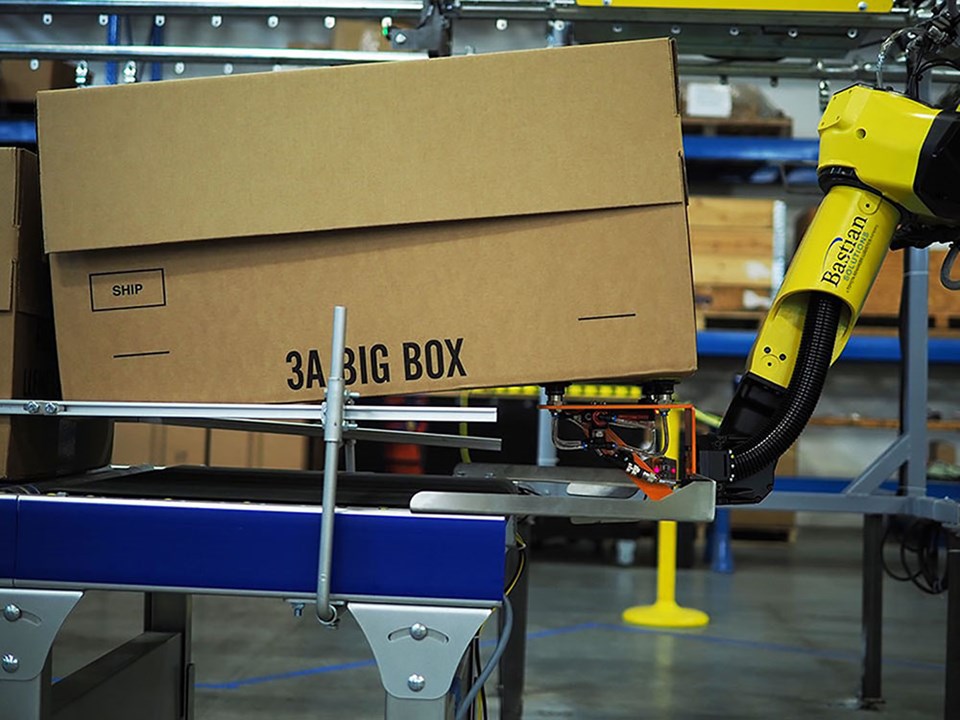
Automated Empty Case Delivery via Robots and Overhead Monorail
Mitch Stevens | 18 August 2021
In many distribution centers, timely order fulfillment relies on operators having access to empty boxes so that they can quickly complete their picks. This is often completed by building a box and then delivering it to the operator within the pick module. The question is – “What is the best way to get the box from the box erector to the operator?”
Traditionally, this is completed with an automatic box erector and standard live-roller conveyor. The case erector builds the case, applies a bottom seal and discharges the case onto a conveyor which transports it down a single pick module aisle to an operator. While this gets the job done and may be the right solution for certain applications, is it the right solution for your pick module?
What if the box erector cannot be located within proximity of the pick module? Or, maybe a single box erector can supply enough cases for all aisles of a multi-aisle pick module? If either of these scenarios are the case for your facility, a robotically loaded monorail may be the best solution for empty box delivery.
Robotic Empty Case Loading: How Does it Work?
With this type of system, boxes can be automatically erected and staged on an accumulation conveyor. The robot then picks the box from the accumulation conveyor and places them onto a monorail carrier as it passes by.
To keep the process flow, the robot uses line-tracking software to track the carrier position along the path of the monorail so that the monorail doesn’t have to stop for the case placement onto carrier. The box then travels to the pick module.
From there, operators can reach and grab empty cases from the monorail as they need them throughout the pick aisles. When empty, the carriers loop back around to the robot where the system continues with the next empty box onto the carrier.
Benefits of a Robot and Monorail Case Delivery Solution
Industrial robots combined with specially designed end of arm tools add increased flexibility to the products and materials that they can pick up and maneuver; opening the range of box or case sizes and variability that they can handle. The benefits of these solutions, however, stretch beyond the case itself.
Conveyor Cost: The total installed cost for an overhead monorail conveyor is roughly three-times less than that of traditional live-roller conveyor. If the box erector cannot be placed within close proximity of the pick module, traditional conveyance could be expensive, install could be intensive and there may a lot of floor space opportunity lost.
Access within Pick Module: The monorail can be installed overhead. This will open up floor space for walk paths, conveyors or other uses. It could also allow the operator to access both sides of a pick aisle without having to walk over a conveyor or through a conveyor gate.
Single Box Erector: Since the monorail can easily be routed down multiple pick module aisles, a single box erector can be used to feed empty cases to an entire multi-aisle pick module.
Box Erector Location: The erector can be located anywhere in the facility, which can open up floor space near the pick module in addition to layout flexibility.
Robot to Monorail Loading: With the addition of the robotic technology to load the boxes onto the monorail carriers, no additional labor is required. The robotic technology can be integrated with existing case erectors and monorail conveyor, making them cost effective automation tools compared to traditional conveyor.
Efficient DC Picking Operations
Global market, ecommerce surge and consumer buying behavior changes calls for greater efficiency in DC operations. Robotic technology is rapidly developing with increased applications in various industries. From each picking to bridging the gap between box erectors and pick modules, these robotic solutions introduce high levels of reliability, flexibility and speed. Let one of our many skilled engineers guide you through the process of determining the right solution for you and your organization.
Mitch is a field application engineer for Bastian Solutions' robotics division. He has Bachelor of Science degree in mechanical engineering from the University of Illinois. As an application engineer, he helps Bastian Solutions’ customers find the right robotic solution for a variety of applications, some of which include palletizing, machine tending, packaging and assembly.
Comments
No comments have been posted to this Blog Post
Leave a Reply
Your email address will not be published.
Comment
Thank you for your comment.